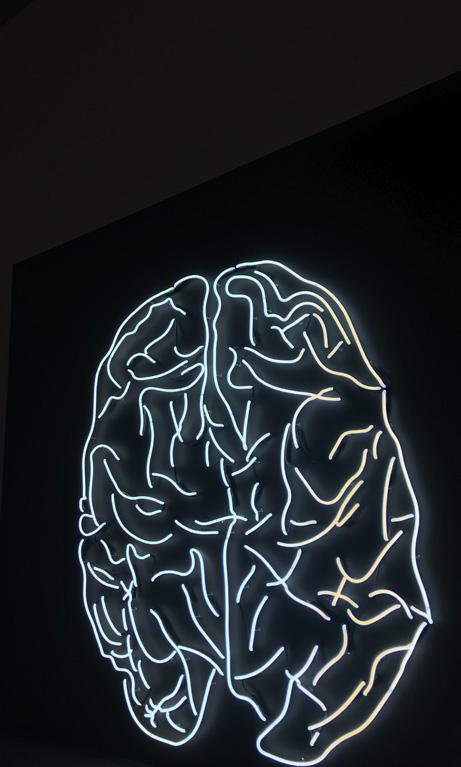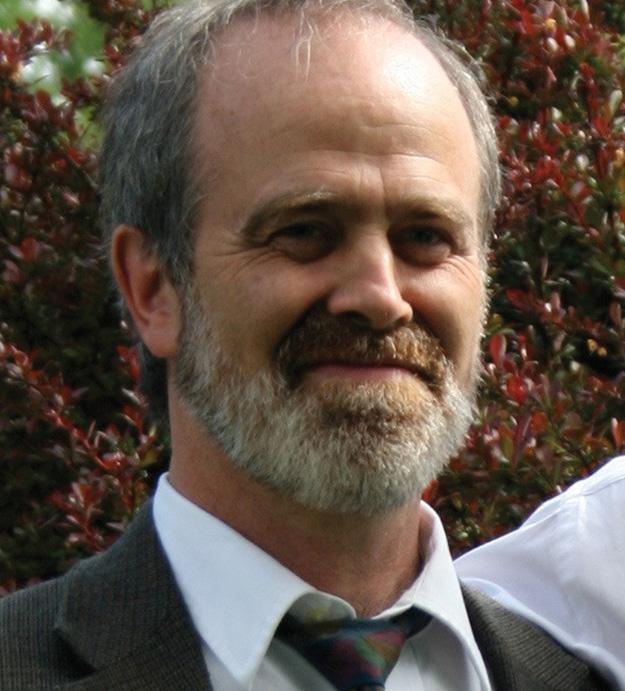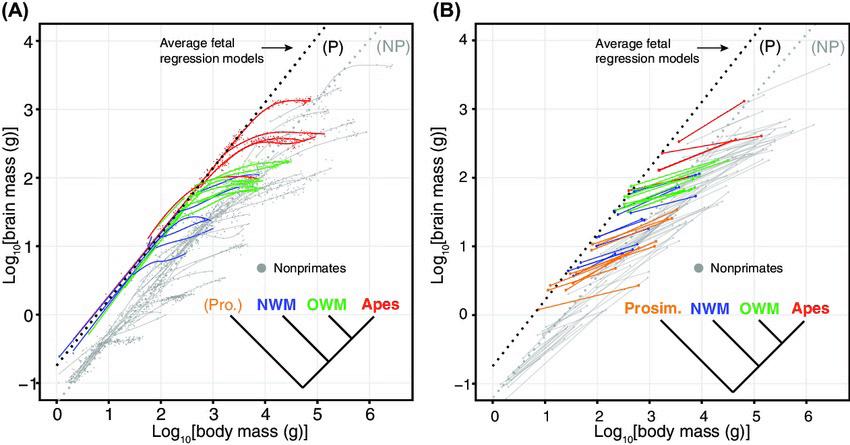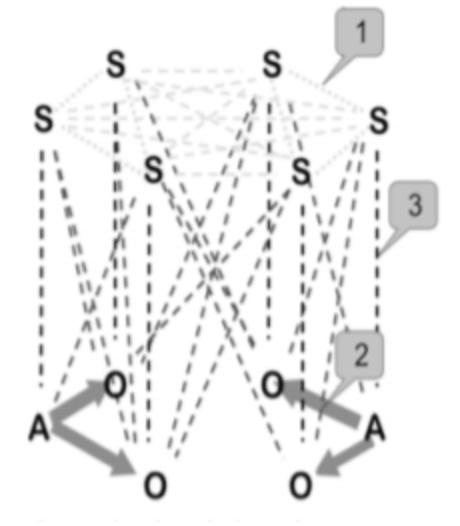
19 minute read
The Human Brain and the Evolution of Language (Dr. Terrence Deacon
THE HUMAN BRAIN AND THE EVOLUTION OF LANGUAGE
Interview with Professor Terrence Deacon
Advertisement
BY ELETTRA PREOSTI, MELANIE RUSSO, KATIE SANKO, KATHERYN ZHOU, AND MATTHEW COLBERT
Dr. Terrence Deacon is a current Professor and former chair of the Department of Anthropology at UC Berkeley. He is also a member of the Helen Wills Neuroscience Institute. Professor Deacon’s work combines human evolution, semiotics, and neuroscience to examine how humans evolved the capacity for cognition and language. In this interview we discuss his findings on what sets humans apart cognitively from other species, and how those differences and further evolutions allowed for the use of language.

BSJ : You originally did your PhD in biological anthropology at Harvard, and now your research is in neurology, linguistics, information theory, and even the origin of life. How would you describe the path your research has taken, and how would you describe your focus now?
TD: My PhD at Harvard was actually about the neural connections in monkey brains that correspond to areas in the human brain associated with language. Even though it is a biological anthropology PhD, my work was primarily in the neurosciences. I studied neurosciences at MIT as well as Harvard before getting my PhD, and I also got a Masters degree in Education from Harvard, so I had multiple backgrounds. One of the reasons I studied the neurology of language and worked in education was because of my interest in
Professor Terrence Deacon 1
Charles Peirce, the father of semiotic theory, and his way of thinking about language and communication. From there, I became a professor at Harvard for eight years, where I went on to do other studies of how brains evolved. Then, I moved on to Boston University, and then to Harvard Medical School. There, I worked on transplanting neurons from one species' brain to another to understand how species differ in the way their axons make connections to other parts of the brain during development in order to create neural circuits. Using this technique of transplanting neurons from one species to another, we were able to ask questions about what mechanisms were being used to guide those connections to their destinations. I left Harvard Medical School in 2000 and came here to Cal in 2002. I had basically moved on beyond my transplantation research, and
most of my research then moved to more abstract questions. We were interested in how brains grow, how they develop across species, and much more generally language and its evolution.
BSJ : A lot of your work focuses on human evolutionary biology and evolution in the brain. What is encephalization and its significance in human evolution?
TD : Encephalization is a way of talking about how big brains are for a given body size. We think that our big brains for our body size is something very important to our species and that it is clearly something that enlarged during our evolution. If you know the size of the mammal’s body, you can do a pretty good job of predicting how big its brain is (Fig. 1). One of the exceptions keys, apes, and us. In fact, we have brains about three times larger than you'd expect for a typical primate of our size. The rest of the non-anthropoid primates have about twice as much brain for the same sized body as almost any other mammal. That suggested that something was special about primates and us.
Now, the problem with encephalization is that it's not about how big brains are. If you were to look at mice, about four percent of a mouse's body size is made up of its brain. But for you and me, it's two percent; we actually have a smaller ratio of brain to body size than mice. It turns out that as bodies get bigger in different species, brains enlarge to the two-thirds power, sort of like surface and volume relationships. When you enlarge a sphere, the surface increases to the square, and the volume to the cube. Well, that's sort of the way the brain expands. Over the course of the last century, people have tried to figure out why that's true. One of my hypotheses that we've tried to test, but can't get a really definitive answer to, is that brains develop from the same primordial part of the embryo that will turn into skin. Since our body's surface has to enlarge to the square of our body mass, you might think of that as a reason why brains should do the same. However, that doesn't explain why primates deviate and why humans deviate further. We've found that in primate development, it's not brains that are changing; it turns out the bodies of primates grow slower than the brain. At the same time, we've found that all brains of mammals grow at the same rate. That means that humans’ unusual brain sizes can't be the result of our brains growing a lot faster. Instead, they grow for a longer period of time. Humans are like other primates in the womb, but we keep growing our brains a little bit longer, so we end up having a much larger brain. So, there are actually multiple ways that brains and bodies can be out of proportion, and this af
to this is primates, and anthropoid primates in particular: monfects the connection patterns in the brain. Simply changing the relative sizes of brains changes how axons find their targets and how connections get formed. If you change the total proportion of the brain in relation to the body, you'll also change the way these axons compete for connections. This is almost certainly what accounts for some of our own differences.
BSJ : What aspects of the human brain allowed us to develop the unique cognitive and linguistic abilities lacking in our closest homologues?
TD : One of the things that’s really obvious about us is the connection between our cerebral cortex, the motor area that controls skilled movement, and our larynx muscles. Because of this, I can articulate the movement of my mouth, tongue, and lips really precisely and consistently with the timing of vocalizations from my larynx. Other species that don’t have this direct connection to the larynx can’t coordinate the production of sound with the articulation of their mouth, tongue, and lips. That’s clearly one of the things that makes speech possible. My work has suggested it’s because of a change in the prefrontal part of the brain, which plays a big role in dealing with multiple possibilities at once. When answering a multiple-choice question on an exam, you have to hold multiple options in your head at once and then sort through them. These functions are pretty important in language. Now, does that mean that we’re more intelligent? Well, it turns out there are some tests that we would think correspond to intelligence that we don’t do as well on as chimpanzees. This is interesting because it means that some of our capabilities have been traded off for other capa
Figure 1: Logarithmic graphs showing primate brain size versus body size in grams. 2 The mammalian average can be seen in the left graph. (Reproduced from Halley and Deacon, 2017.)

bilities. For example, language uses our memory in very unique ways. Other species have a memory system like ours in the following sense: when you learn a skill, you learn by repeating it again and again. However, what you had for breakfast two days ago isn’t something you’re able to repeat; it happened once. What you did on your seventh birthday is maybe something you could go back and recover with a bit of effort. This kind of memory is the result of connectional or associational redundancy: because you are this many years old, you can make the connection to what town you were living in when you were seven years old, what school you were going to, and so on. We can use all these things to zero in on that memory. It turns out those two memory systems are controlled by two different parts of the brain. A structure called the hippocampus is involved in the memory of one-off events, sometimes called episodic memory, because it has to do with episodes in our life. The other is procedural memory, which is controlled by structures called the basal ganglia. It turns out language is the result of both. Language involves things we repeat over and over again. But when you want to remember something that’s complicated in terms of its associations, you need this other kind of memory. We remember things as stories, as theories, as ideas, as histories; even our own personal identity is defined by the way these kinds of memories are linked to each other. Language has allowed us to use our memory systems in absolutely novel ways. So, we think about and remember the world differently from other species precisely because of our language abilities.
BSJ : How did these findings inspire your theory of coevolution in humans?
TD : In the 1990s, I was beginning to look at how human activities changed the world, which then will change humans. Today, we call this niche construction: a niche is the environment that an animal adapted to live in and has specializations for. Beavers are a great example of an animal that creates its own niche by building dams to create an aquatic environment that it’s adapted to. Well, in a real sense, humans have constructed this niche that we call language and culture that we have adapted to. My argument about coevolution concerns the fact that changes of the brain have changed the possibilities of communication and social organization, which have created this specialized niche of culture and patterns of activity that are shared socially. In turn, this has changed our brains so we can learn language more easily and interact with each other. Over the course of a bit more than two million years, we’ve become adapted to the world that we’ve created, and one of the ways we’re so different from other species is that we’ve adapted to this niche.
BSJ : What exactly is language in terms of your research and how does that differ from its traditional colloquial definition?
TD :We all know what language is because we’re using it; exactly how it’s different from other forms of communication has really been a challenge to define. My approach came early on from studying the semiotic theory of Charles Sanders Peirce, who said we communicate in lots of ways that are not linguistic. Just think about laughter and sobbing. A laugh doesn’t have a definition, it’s something we do. We can describe the context in which we produce it—say it’s associated with a particular emotional state— but it doesn’t have a definition. Our brains have effectively evolved the ability to do other kinds of communication besides language, what Peirce called iconic and indexical communication. Iconic communication is pictorial-like and it has to do with things that look, sound, or feel like something else. We have lots of knowledge that is based upon this kind of relationship. In fact, after this conversation is done, you won’t remember hardly a single sentence that I’ve talked about, but you’ll have a mental picture of what it was about. That’s very different from language. On the other hand, we use a lot of indexical communication. Human beings are specialized for pointing, and children learn this well before they learn language. Unfortunately, linguistics sort of takes language out of the context of communication in the body and asks about things like the structure of a sentence. This led to one of my teachers in the distant past, Noam Chomsky, arguing that the meaning of words is totally independent from the grammar and syntax. A lot of my work had to always place language in the context of non-linguistic communication, particularly because it was about how language came about in the first place. The evolution of language in our species had to grow out of non-linguistic communication. So, iconic and indexical communication is the basis of our linguistic capacities. If you only focus on the grammar and syntax of sentences, you miss the infrastructure on which it's built. It’s the icing on the cake. Unless you focus on this rest, you won’t understand how the icing got there, so to speak.
BSJ : We were looking at your work on language development and how words get their meanings and were wondering if you could talk to us about the symbol grounding problem?
TD :The symbol grounding problem derives from the fact that you can think about symbols like words and imagine that

Figure 2: A demonstration of the possible relationships between a
sign (S), an object (O), and an action (A). 4 Line 1 denotes a sign-sign relationship, line 2 denotes a sign-object relationship, and line 3 denotes a sign-action relationship. (Reproduced from Raczaszek-Leonardi and Deacon, 2018.)
they’re arbitrary. They don’t carry any clue inside them, and that knowledge isn’t in the context of other kinds of communication. Then, you have to wonder how you ever have symbols map to what they refer to. In our work, we recognized that children begin with symbols that have no clues carried within them. They come into a world where other people are communicating with these things and they have to figure out what’s going on. By the time they start learning the language, children have a lot of experience communicating iconically and indexically: pointing, gesturing, reaching, exchanging objects, and all kinds of things that go on during the first year of life. An icon is grounded because the sign vehicle itself has some likeness to what it refers to; an index like pointing has to be associated with what’s being pointed at (Fig. 2). As a result, iconic and indexical communication are grounded—you can look at the sign vehicle itself and know what it refers to. We have to use grounded communication to figure out how to use ungrounded sign vehicles. So how does a child do this? This is what we call the symbol grounding problem. They’ve got to use signs they’re already familiar with and figure out how to throw away that groundedness and yet not lose the reference. If the grounding is not inside the sign vehicle, it has to be in the relationship of the sign vehicles to each other, which is grammar and syntax, which have basically internalized a lot of more grounded sign relationships. Those relationships are used differently in different societies, cultures, and languages.
BSJ : In regard to your work at Harvard Medical School with Ole Isascon on neuro-transplantation and Parkinson’s Disease, you found that fetal porcine dopaminergic neurons were able to survive and restore these nonfunctional pathways in rats. 5 Is it surprising that neurons from one species can function in another? TD : It is surprising in two senses. Number one, when we transplanted rat neurons into the rat brain, it didn’t work. You would expect that rat neurons should be the ones that really work, but they didn’t because they couldn’t quite find their connections. There turns out to be a reason for this. In adult brains, axons are impeded from growth. It turns out that rat neurons take only a week or so to mature, which wasn’t enough time for them to find their connections. Interestingly enough, pig neurons take months to mature. As a result, when transplanted into the rat’s brain, even though it was a different species, the same molecular signals that direct neurons to grow in a specific place turned out to be in both rat and pig brains, and even human brains. Because the pig neurons were slower to mature, they made connections that rat neurons could not, so the pig neurons improved the Parkinsonism of these rats. It was surprising that the cross-species transplantation worked better than the transplantation within the same species. But it showed that the time course of maturation of neurons really mattered in this process. It showed something else surprising as well. Even in adult brains, the rat neurons that would guide axons to their targets were still there. We even did electron microscopy to show that synapses formed directly between pig and rat neurons that affected the formation of working connections. Now, pigs and rats have almost certainly been apart in evolution for more than 65 million years. Even though they are this far apart in evolutionary time, they are using the same neuronal guidance mechanisms. This says that brains are based on really conservative mechanisms, even though the size of the brain, the body, and the structures have changed a lot. In one sense, it’s good news because this means that brains are generic enough that you can use these techniques. But

Figure 3: The first neuron transplantation patient for Parkinson's Disease in the initial
study. 6 Photo courtesy of Professor Deacon.
there is bad news here as well. If you were to place human fetal neurons to repair the brain, their axons wouldn't grow far enough to reach their targets. You have to get neurons from a brain that grows much slower. I doubt that we're ever going to raise whales for this purpose. In Parkinson’s disease, a whole class of neurons have died,
and it turns out that we can replace them by transplantation. The bad news is that the repair will take years in order for the neurons to find their targets.
It turns out that some of the work we did has been replicated in humans. In fact, I did some of the first autopsy work showing pig neurons transplanted into human brains in Parkinson’s cases. This was a set of studies done by a company called Genzyme, who effectively took the technology and ran with it, thinking that they could make this work. There were as many as 12 patients in the initial study, and there was improvement for a couple of the patients. In fact, the very first patient was significantly improved. He had spent his recent years mostly confined to a bed or chair. After the transplantation, although it took a couple of months before he had any kind of improvement, he actually was able to get up and walk around. He even tried to play golf at some point (Fig. 3). Unfortunately, all of the grafts were eventually rejected. Now, there are many other techniques that we are beginning to be used for Parkinsonism, and transplantation is probably not going to be the approach. In this process, we learned a lot about the differences between species, how axons find their targets, and that brains are very conserved in the mechanisms they use to make connections happen.
BSJ : What aspects of the human brain make emulating it so difficult in artificial intelligence (AI) systems? How close do you think today’s AI systems are to capturing human brain activity?
TD : One major part of the story is that neurons are trying to keep themselves alive. Techniques we have for looking at brain function in vivo all use metabolism: both PET scans and fMRI look at metabolism. We know that the metabolism of certain areas goes up and down depending on what we’re thinking, and this tells us brain function and energy use in that region are coupled. In a computer, none of the elements have any kind of variation of electrical activity. None of the components are worried about staying alive, nor is their activity affected by changing the amount of metabolism there. In brains, neural activity and metabolism are coupled in a really complicated way. The other important difference is that units of information in the computer are states. In my computer I don’t have a hard disk, just memory chips, which are little transistors that can hold a charge. This pattern of charge is the unit of information, and then I run electricity through it and it does things. The problem in the nervous system is that the unit of information is probably not just a state or structure. Connections are structures that change, and thinking, acting, and perceiving are dynamical processes. It’s not a state, and it’s not the relationships between one state to another state. In some respects, artificial intelligence is very much like the theory of behaviorism from a half century ago. Behaviorism came out because people wanted to make psychology scientific, and the only way to do it if you couldn’t look at what brains were doing was to look at the inputs and outputs. That’s exactly what we do with neural net artificial intelligence. We give it lots of inputs, we strengthen some relationships between the inputs and the outputs, we punish others to eliminate some of those connections, and eventually we get the input-output relationship that we want. Imagine we give a neural network thousands or hundreds of thousands of pictures of cat faces, and eventually it recognizes cat faces and distinguishes them from dog faces or automobile pictures or human faces. But, a child of three could see three cat faces, and from that point on be able to recognize what’s a cat and what isn’t a cat. For our neural net research, it takes thousands, oftentimes millions of trials, to get that kind of capacity with artificial intelligence. This also tells us that what we’re doing computationally is something fundamentally different from what brains do. That doesn’t mean we couldn’t make devices to work like brains, it just means we’re not doing it yet, and we maybe don’t have an idea of how to do it because we have components that don’t work like neurons work. Will it ever happen? Probably so. Should we want to do that? Probably not.
1.
2.
3.
4.
5.
6. REFERENCES
Terrence Deacon [Photograph]. Retrieved from https://www. goodreads.com/author/show/389341.Terrence_W_Deacon Halley, A. and Deacon, T. (2017) The developmental basis of evolutionary trends in primate encephalization. In Evolution of Nervous Systems, 2nd Ed. Vol. 3 (J. Kaas & L. Krubitzer, eds.), Oxford, UK: Elsevier, pp. 149-162. Raczaszek-Leonardi, J., Nomikou, I., Rohlfing, K. J., & Deacon, T.W. (2018). Language development from an ecological perspective: ecologically valid ways to abstract symbols. Ecological Psychology 30: 39–73. Raczaszek-Leonardi, J. and Deacon, T. (2018) Ungrounding symbols in language development: implications for modeling emergent symbolic communication in artificial systems. 2018 Joint IEEE 8th International Conference on Development and Learning and Epigenetic Robotics (ICDL-EpiRob), pp. 16-20. doi: 10.1109/DEVLRN.2018.8761016 Isacson, O. and Deacon, T. (1997) Neural transplantation studies reveal the brain's capacity for continuous reconstruction. Trends inNeurosciences 20: 477-482. Deacon, T., Schumacher, J., Dinsmore, J., Thomas, C., Palmer, P., Kott, S., Edge, A., Penney, D., Kassissieh, S., Dempsey, P., and Isacson, O. (1997) Histological evidence of fetal pig neural cell survival after transplantation into a patient with Parkinson's disease. Nature Medicine 3(3):350-353










